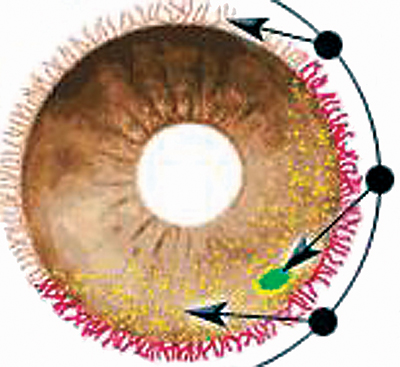
A 16-year-old patient who wears daily wear contact lenses admits to sleeping in them despite my warnings that this is an unsafe practice. The patient and his parents are interested in extended-wear (EW) lenses, which his prescription allows. Should I prescribe them to him?
Your decision to prescribe EW lenses to this patient depends on your confidence in his ability to comply with the lens-care regimen.
A 16-year-old who is already sleeping overnight in his daily wear lenses is a good candidate for lens overwear and abuse, says John Class, O.D., J.D., of Birmingham, Ala. Therefore, before attempting to fit him in an extended-wear lens, talk with both the patient and his parents about the risks involved with extended wear, such as ulcerative keratitis, to assess the teenagers maturity and thus ability to comply with the EW lens regimen.
 |
| Your decision to prescribe extended-wear lenses to an underage teen depends on your confidence in his or her ability to comply with the contact lens care regimen. |
If you dont believe this patient will comply with your directions, which seems highly likely with this patient, do not fit him in extended wear. You may want to discontinue prescribing contact lenses to him altogether. If, however, you feel confident that the patient will achieve good compliance, then you could prescribe them to the patient after youve educated both him and his parents about the risks associated with extended lens wear, says Michael Harris, O.D., J.D., of the University of California, Berkeley, School of Optometry.
Pamela J. Miller. O.D., J.D., of Highland, Calif., does not prescribe EW lenses to minors because she believes they are not mature enough to fully understand or appreciate the risks associated with these lenses. These patients certainly understand the benefits, but they just dont understand the risks, which makes this population less likely to comply with this lens-care regimen, she says.
Instead of prescribing EW lenses, Dr. Miller suggests you talk with the patient and his parents about switching to daily disposable lenses. I do not advocate two days of daily wear. But unfortunately, many daily disposable patients wear their lenses for two days (one night), despite being told not to. If this is the case, document it, and emphasize to the patient that a daily disposable is just that, she says. Should the patient decide to wear these lenses two days, however, Dr. Miller says that because each individual lens is fresh and clean, the risk of ocular complications is minimized. Also, she says she has never had a patient exceed two days because the lenses become so uncomfortable that the patient must remove them.
If the patient and his parents insist on EW lenses, how do I minimize the legal and clinical risks?
To protect yourself against a malpractice claim, have proof of informed consent by the patient and the patients parents. The consent form should include a description of the patients condition and all of the in-formation that was discussed with the patient and his parents regarding EW lens wear, Dr. Harris says.
Specifically, the form should list:
Why you recommended the lenses.
Alternative visual options for the patient, such as spectacles or daily wear lenses.
Potential risks associated with extended wear in this age-group, such as infiltrative keratitis or ulcerative keratitis.
Warning signs of ocular problems stemming from EW lens use, including instructions for the parents, should the patient experience any of the listed warning signs.1
 |
| Young adults who wear extended-wear lenses are at a higher risk for infiltrative keratitis. |
The standard of showing that you provided all this information to the parents is their signatures on the document. Their signatures indicate that they understand everything on the form and that they willingly and knowingly accept the risks involved, Dr. Harris says.
Have a staff person present at the time you give the informed consent discussion so that he or she can sign the document as a witness, he adds.
Additional proof of informed consent: documentation in the patients record that you advised the parents about the EW lens-related issues mentioned above or a video or audio tape of the informed consent discussion.
To minimize the clinical risks associated with extended wear in this patient:
Limit lens wear. Unfortunately, its not a matter of if contact lens patients are going to abuse their lenses; its a matter of when, Dr. Miller says. For this reason, I tell all my EW lens patients that they are to wear their lenses for no more than three nights of consecutive wear, which is quite a bit less than what the FDA guidelines are, and I document this in their record.
Other practitioners may advocate up to 30 days of wear, as it precludes the patient from handling the lens and thus reduces the likelihood of contamination. When the patient does remove his lenses more frequently, he must be instructed to wash his hands, use an FDA-approved CL disinfecting solution and clean and rinse the lens well.
Ask the parents to be certain the patient is compliant. For example, the parents could watch him take the lenses out on the designated no wear night, Dr. Class says. The parents must have a sense of responsibility for the teens compliance.
Educate the patient and his parents about the importance of rewetting the lenses upon waking. The patient needs to understand that this is crucial to prevent the lens from adhering to the cornea. Have the patient place a couple of rewetting drops in each eye and then use his lids to move the lens around a bit, Dr. Miller says.
Implement conservative patient follow-up. Schedule appointments at sufficient intervals to detect complications of wear, and check the number of lenses worn over a given period, Dr. Class suggests.
Dr. Harris agrees. If you suspect there is a need to see the patient more frequently than six months, certainly you should make that recommendation, and document it in your records, he says. In addition, document it if the patient misses any appointments.
Each exam should include a discussion of good lens-wearing habits to reinforce compliance, Dr. Class says.
If the patient does not comply with your instructions, should you drop him as a patient? You have to look at each patient individually, and ask yourself: Would I rather see this patient and continue to try my best to protect him, knowing that he is getting the best care, or have him see someone else who may not provide the best care? Dr. Miller says. You have to make that judgment call.
Dismissing a patient from a practice is always a difficult decision and a great deal like disciplining/firing an employee. First, warn the patient that he is in danger of losing you as his practitioner, and document this in his record. If that doesnt work, send a letter to the patient (request return receipt) indicating that because he is noncompliant with his lens care and replacement, you will no longer be able to see him in the practice, and his records will be forwarded to the practitioner of his choice, Dr. Miller says. You should document in the letter the areas of concern, potential areas of harm, and the fact that the patient has repeatedly ignored your instructions to comply.
If, however, the patient returns to your office and promises to be good, you can reconsider seeing him as a patient, but be certain to document this promise, see the patient more frequently, and have him or her sign a written agreement promising to comply with your instructions and replacement regimen, she adds.
1. Schein OD, McNally JJ, Katz J, Chalmers RL, et al. The incidence of microbial keratitis among wearers of a 30-day silicone hydrogel extended-wear contact lens. Ophthalmology 2005 Dec;112(12):2172-9.

